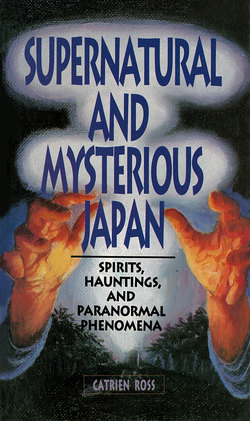Читать книгу Supernatural and Mysterious Japan - Catrien Ross - Страница 9
На сайте Литреса книга снята с продажи.
ОглавлениеCHAPTER TWO
Psychic Stirrings
An important thread in Japan’s supernatural tapestry is human psychic power. There have always been people able to enter another dimension of existence where “superpower” becomes possible. Japanese shamans called miko, for example, have long stood as agents between the ordinary world of human beings and the realms of the gods and the spirits. Traditionally unmarried women, miko communicate essential wisdom and exercise valuable healing gifts.
Their role was probably first defined during the Age of Kami. The sun goddess Amaterasu had hidden herself in a celestial cave in disgust at the numerous outrages committed by her brother Susanoo. As a result, the heavens and earth had darkened. To cajole her into coming out again, the other Kami arranged entertainment, and the heavenly shaman Ame no Uzume danced in front of the cave. Eventually Amaterasu emerged, and heaven and earth brightened once more.
In Japan’s long history of shamanic and mediumistic practice, especially among religious groups, the ability to tap psychic potential has always played a part. It was not until about the mid-nineteenth century, however, that the paranormal phenomena taken for granted by members of such groups began to be investigated more objectively. Researchers started to examine Japanese people with supernatural powers in an attempt to illustrate and understand what was happening. At the same time, public interest was piqued by sensational press coverage of a number of colorful personalities. A variety of psychic abilities was showcased: clairvoyance, mediumship, telekinesis, and healing. There was sensation and secrecy, skepticism and suicide.
Among the early investigators was the Edo-era scholar Hirata Atsutane, whose specialty was Shinto, but who also looked into poltergeist and reincarnation. Another mystic researcher was Honda Chikaatsu, whose studies in meditation tied to divine possession led him to become a medium. His psychic training techniques were further developed within Omoto, a Shinto-related sect founded by the woman mystic Deguchi Nao in 1892, and whose members would themselves in turn establish various psychic and religious circles. In fact, beginning in 1814 and continuing for several decades afterward, there was a blossoming of religious movements which centered around faith healing, and became widely popular among Japan’s peasant masses. A forerunner of these schools was the Kurozumi sect, which emphasized faith in the Sun Goddess, and was founded in 1814 by the Shinto priest Kurozumi Munetada. Kurozumi claimed mystical vision after recovering from a severe illness. The Tenri sect was started in 1838 by Nakayama Miki, a faith healer and wife of a farmer near Nara Prefecture. Still thriving today, it has established a major religious complex in Tenri City, Nara. Kawade Bunjiro, a farmer, established the Konko sect in 1859.
Deguchi Nao was born in the Kyoto Prefecture castle town of Fukuchiyama in 1836, during a period remembered as Tenpo no Daikikin, a time of famine and natural disaster, when several hundred thousand people died throughout Japan. Her family, Kirimura, had once been fairly well-to-do but had gradually become impoverished, and when she was ten years old, she was sent to work as a domestic servant. She returned home almost seven years later, and was then adopted into her aunt’s family, Deguchi, in 1853. At the age of nineteen, she entered into a marriage that would last thirty-two years, until her husband’s death in 1887. Five years later, in February 1892, she had her first religious vision when a god appeared to her and she began speaking aloud in a man’s voice.
After several unsuccessful attempts at exorcism, she decided to accept her possession by a god she called Ushitora no Konjin, or the Golden God of the Northeast. After she was ordered by this god to undertake special training with water, her psychic powers developed rapidly, and she began engaging in healing, clairvoyance, and automatic writing. Prophesying—correctly, as it would turn out—Japan’s war with China and then with Russia, she was arrested on April 21, 1893 on false charges, and after her release was held under house arrest for forty days.
